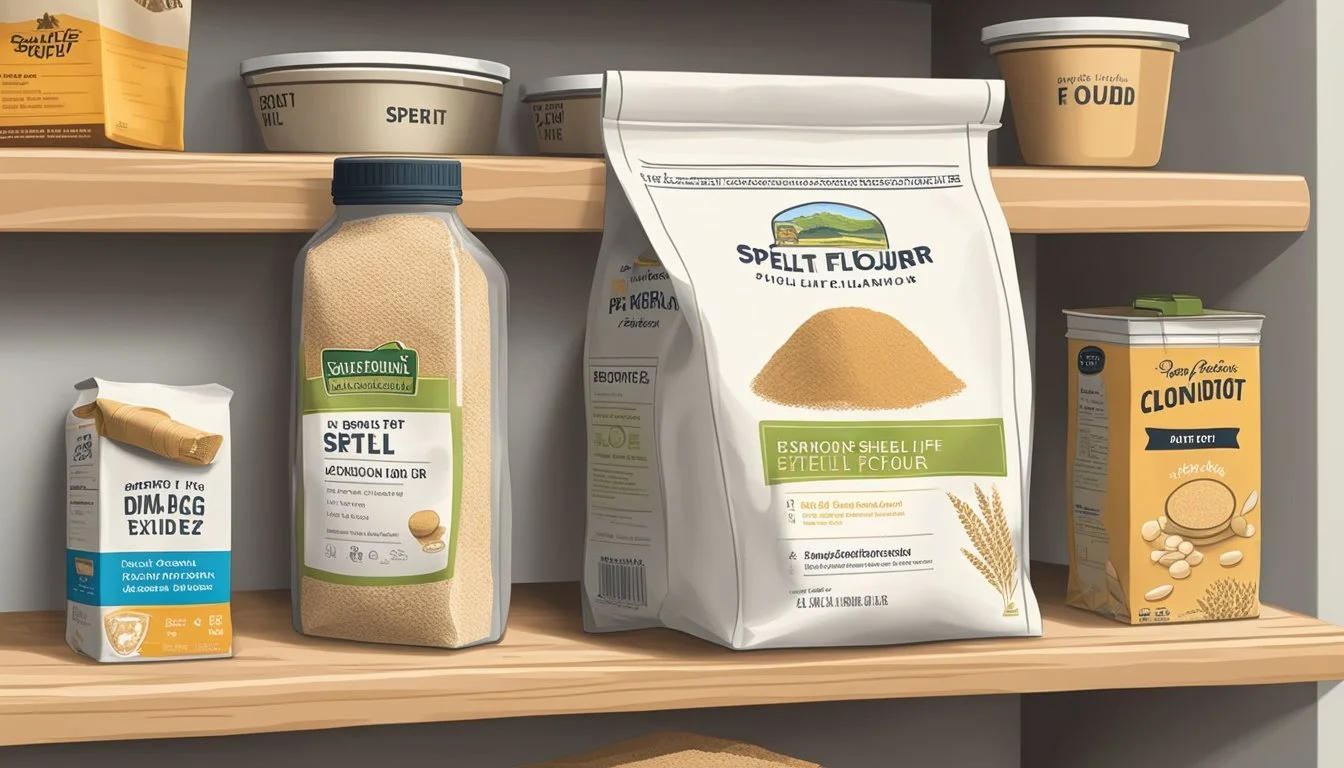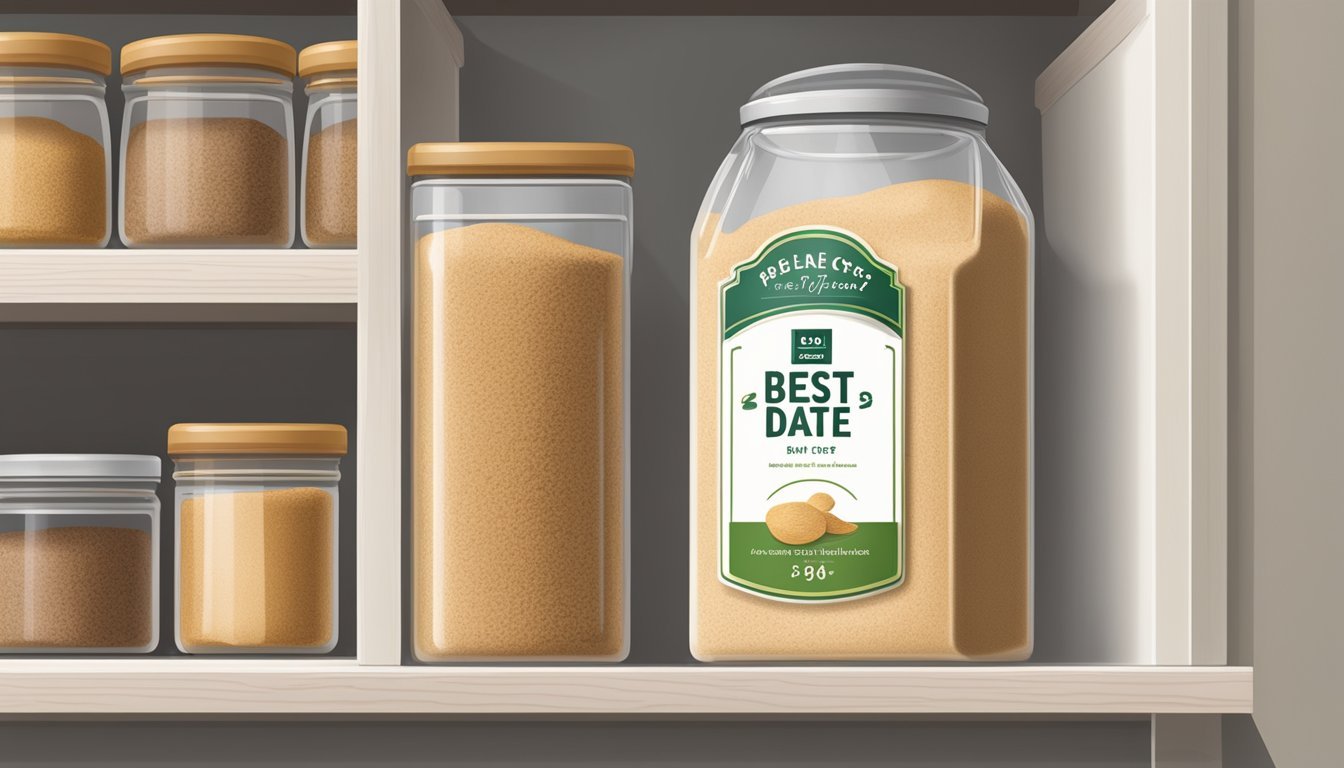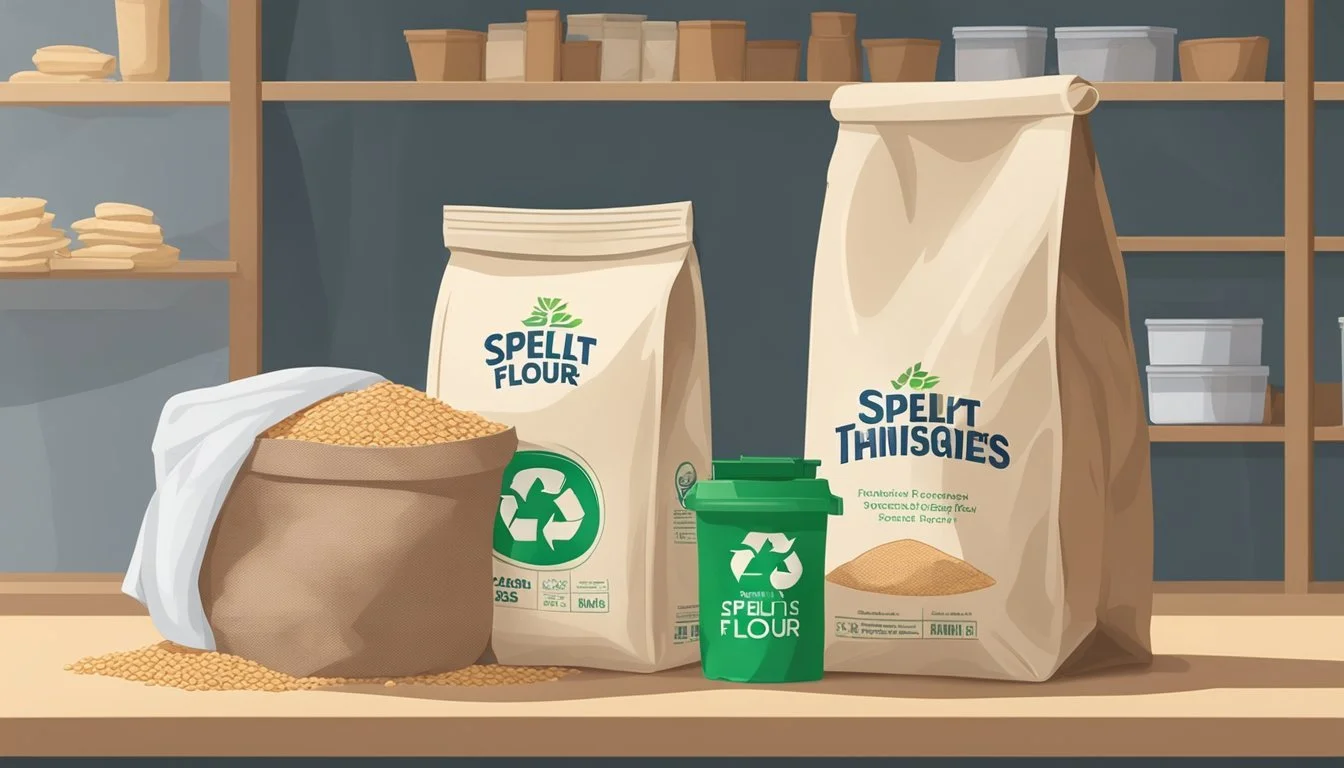How Long Does Spelt Flour Last?
Shelf Life and Storage Tips
Spelt flour (how long does spelt flour last?), a whole grain flour derived from an ancient variety of wheat, is known for its rich nutrient profile and distinctive nutty flavor. As with many whole grain flours, its shelf life is a consideration for consumers who wish to maintain the flour’s quality and nutritional value. The longevity of spelt flour is influenced by several factors, including storage conditions and whether the flour has been opened or remains sealed.
Under optimal conditions, spelt flour generally lasts between six months to a year when stored at room temperature. To maximize its shelf life, spelt flour should be kept in a cool, dry place away from direct heat or sunlight. Refrigeration or freezing can extend its freshness further, potentially preserving the flour's quality for up to two years.
Signs of spoilage in spelt flour are similar to other whole grain flours. An off or rancid smell, discoloration, or a change in texture are indicators that the flour may have gone bad. If any of these signs are present, it is advisable to discard the flour to ensure that baked goods maintain their desired taste and quality.
Understanding Spelt Flour
Spelt flour is a distinctive whole grain flour that offers a range of nutritional benefits and a unique flavor profile. It is an ancient grain that has become a popular choice for those seeking alternatives to modern wheat flours.
The Basics of Spelt Flour
Spelt flour is made from spelt, an ancient grain related to wheat. Historically, it was a staple in parts of Europe. Unlike common wheat, spelt retains its husk during threshing, which may help protect the grain’s nutrients. When ground into flour, spelt provides a nutty and slightly sweet flavor unique to this grain.
Protein Content: Spelt flour contains a moderate amount of protein.
Fiber Content: Higher in fiber compared to all-purpose flour.
Nutrients: Rich in various nutrients, including B vitamins, iron, and magnesium.
Spelt Versus Other Flours
When comparing spelt flour to other flours, it's important to consider its gluten content and baking characteristics. Spelt flour has a lower gluten density than modern wheat flour, which can lead to a tender crumb in baked goods. However, because it contains gluten, spelt flour is not suitable for those with celiac disease.
Whole Wheat Flour (how long does whole wheat flour last?): Spelt is often touted as more digestible than whole wheat flour, though it still contains gluten.
All-Purpose Flour: All-purpose flour has a refined lighter texture and different nutritional profile. Spelt flour is commonly seen as a healthier whole grain alternative.
Whole Grain Flours: Spelt flour is one among other whole grain flours, each offering unique flavors and nutritional profiles.
Health Benefits of Spelt Flour
Those who consume spelt flour benefit from its nutritional composition. This flour is a good source of dietary fiber, which is essential for digestive health. It also contains essential nutrients that are important for overall health.
Dietary Fiber: An excellent source of fiber that supports digestion.
Nutrients: Supplies minerals like iron and magnesium and is also a good source of vitamin B3 (niacin).
Protein: The grain contains a decent amount of protein, making it a valuable addition to a balanced diet.
Storage and Shelf Life
Proper storage of spelt flour affects both its shelf life and the preservation of its nuanced flavor. Ensuring flour is kept in the correct environment can maintain its quality for consumption.
Optimal Storage Conditions
When storing spelt flour, it should be in an airtight container to protect it from moisture and contaminants. A pantry that is cool, dry, and away from direct sunlight supports a stable environment, as both heat and light accelerate the degradation process. Spelt flour, like other whole grain flours contain oils from the grain's germ, hence, it is more prone to spoilage compared to refined wheat flour.
Pantry: Ideal for short-term storage.
Refrigerator: Recommended for extending shelf life.
Signs of Spoilage
Spelt flour will exhibit tell-tale signs when it has gone bad:
Smell: A sour or off odor is a sign that spelt flour should not be used.
Taste: Any bitterness or an 'off' taste indicates spoilage.
Pests: Presence of insects or larvae in the flour.
Mold: Any visible mold growth or discoloration.
One should inspect their flour regularly to ensure it remains suitable for baking.
Extending Shelf Life
To maximize the shelf life of spelt flour:
Remove Air: Seal the flour in an airtight container to limit oxidation.
Control Temperature: Store in a refrigerator to significantly slow down the spoilage process.
Keep Dry: Avoid any contact with water or moisture, as this will encourage mold growth.
While spelt flour typically lasts up to six months in pantry storage, refrigeration can extend its shelf life by an additional eight months. Unlike gluten-free options that might have differing shelf lives, spelt flour as a whole grain needs careful storage to maintain its distinct flavor and baking qualities.
Culinary Uses
Spelt flour, known for its slightly nutty flavor, is a versatile ingredient in the kitchen. It imparts a delicate taste and wholesome nutrition to various culinary creations. Chefs and home cooks value it for both its taste and its ease of use in an array of recipes.
Baking with Spelt Flour
Baking: Spelt flour shines in the realm of baking, where it is often used as a substitute for wheat flour. Pastry chefs incorporate it into bread recipes due to its mild, slightly sweet and nutty flavor, adding a unique twist to the final product. The flour's properties also lend themselves well to cookies and muffins, where it contributes to a tender crumb and satisfying texture.
When using spelt flour in baking, it is crucial to note that it absorbs less liquid than wheat flour. Therefore, bakers may need to adjust the liquid content of their dough or batter. Additionally, with a different gluten structure, spelt flour requires less kneading; overworking the dough can hinder the final product's texture.
For leavening, recipes should be evaluated case by case, since spelt flour reacts to baking powder and baking soda uniquely. It is typical to allow the mixed dough to rest to achieve the best results.
Non-Baking Recipes
Beyond baking, spelt flour is also a fantastic component in non-baking recipes. It serves as an excellent thickener in sauces and gravies, bringing more body and flavor compared to traditional flour. Handmade pasta benefits from spelt flour's texture and flavor, offering a wholesome alternative to conventional types. Additionally, spelt flour can be included in pancakes batter, enhancing breakfast with a nutritious, flavorful twist.
Its application isn't limited to these dishes, as chefs explore using spelt flour across various baked goods and cuisines, adapting traditional recipes to include this ancient grain. It often requires minor tweaks to existing formulas, but the unique characteristics of spelt can transform the culinary experience.
Nutritional Information
Spelt flour is renowned for its nutritional value, offering a substantial amount of fiber and protein compared to some other grains. Its content is also rich in nutrients such as iron and various vitamins essential to a balanced diet.
Spelt Flour Nutrient Content
Nutrient Content Carbohydrates Approx. 22g per 1/4 cup Fiber 4g per 1/4 cup Protein Approximately 14% of its composition Magnesium 39.9mg Iron Present in significant amounts Fatty Acids Contains essential fatty acids Vitamins Includes B-complex vitamins
Spelt flour contains gluten, although in a different form than common wheat, which some individuals may find more tolerable. However, it is not suitable for those with celiac disease or a gluten intolerance.
Dietary Considerations
Spelt flour is a favorable addition to a high-fiber diet, beneficial for digestion and helping to maintain steady blood sugar levels. Its rich fiber content supports a healthy gut and may promote satiety, which can aid in weight management. The presence of iron and B vitamins in spelt flour contributes to energy metabolism and overall well-being. It should be noted that spelt flour, while nutritious, should be consumed as part of a diverse and balanced diet.
Taste and Texture
When considering the characteristics of spelt flour, its taste and texture are distinctive. They play a significant role in its popularity as an alternative to more common flour types.
Flavor Profile
Spelt flour is well-known for its nutty and slightly sweet flavor, which sets it apart from the more bland palate of conventional wheat flour. The presence of various nutrients contributes to this unique taste, with a depth that can enhance a variety of baked goods. The flour’s inherent flavors may become more pronounced as it ages, but this is also a sign that it may be nearing the end of its shelf life when these begin to shift towards a rancid note.
Comparison with Other Flours
In comparison to other flours, spelt flour's texture is notably different. It has a lighter and softer consistency than whole wheat flour, making it preferable for tender pastries, albeit with less structure due to a slightly lower gluten content. Here's how spelt flour stacks up against other common flours in both taste and texture:
Whole Wheat Flour: A denser, stronger flavor with a heavier texture.
Pastry Flour: Less robust in taste with a finer, starchier texture ideal for pastries.
Gluten-Free Flours: These vary widely, but can include flours like coconut flour, which has a sweet taste and dense texture and often requires different ratios in recipes.
Spelt flour provides a compromise between the hearty taste of whole wheat and the delicate nature of pastry flour, with a unique flavor profile that can enrich recipes. Its versatility also lends itself to being used in concert with other flours to achieve the desired outcome, whether for flavor enhancement or textural adjustment.
Special Dietary Needs
When considering spelt flour in the context of special dietary needs, it is essential to recognize its gluten content and its suitability for vegan diets. Spelt flour is not gluten-free; however, it is often favored in vegan recipes due to its high nutrient profile.
Gluten Sensitivity and Allergies
Spelt flour contains gluten, a protein that can trigger adverse reactions in individuals with gluten sensitivity or celiac disease. Although some people with mild sensitivity find spelt flour to be easier to digest than common wheat, it is not safe for those with celiac disease. When selecting a flour for someone with gluten-related disorders, one should opt for certified gluten-free options.
Vegan and Other Dietary Preferences
For those following a vegan lifestyle, spelt flour is an excellent addition to one's pantry. It is a plant-based ingredient that is suitable for vegan diets and is appreciated for its high-protein content. However, consumers who are vegan should ensure that their spelt flour does not come from facilities that handle animal products to avoid cross-contamination.
Vegan Suitability: Yes
Gluten Content: Contains gluten
Spelt flour's nutrient profile and its capacity to be included in vegan recipes make it adaptable for various dietary preferences, excluding those that require gluten-free solutions.
Cooking and Baking Tips
When cooking or baking with spelt flour, a baker should understand the flour's properties to effectively work with it and adapt recipes. Spelt flour can offer a nutty flavor to various baked goods and responds differently than traditional wheat flour when mixed into doughs and batters.
Working with Spelt Flour Dough
Spelt flour's gluten structure is more fragile than that of regular wheat flour, necessitating a gentler touch when kneading to prevent the dough from breaking down. It should be kneaded just enough to bring the dough together. When making bread, a shorter kneading time is often sufficient, and allowing the dough to rise properly is crucial for a good texture and crumb.
For cookies and pancakes, spelt flour can directly replace all-purpose flour; however, one might observe differences in texture due to the flour's distinctive gluten quality. Cookies made with spelt may have a tender crumb and a slight nuttiness that complements chocolate chips or nuts well.
Substituting Spelt Flour in Recipes
When replacing white flour with spelt flour in recipes, use the following conversions as a guide:
Cakes/Muffins: Start by substituting 25% of the white flour with spelt flour. For instance, if a recipe calls for 1 cup of white flour, use 3/4 cup of white flour and 1/4 cup of spelt flour.
Bread: One can substitute up to 50% of white flour with spelt without significantly altering the structure, although adjustments may be needed for water absorption.
Bakers should also be cautious with leavening agents, like baking soda, when working with spelt flour. Due to the flour's ability to rise quickly, a reduction in baking soda or baking powder might be necessary. Similarly, liquid ingredients in recipes—such as milk or honey—may need to be adjusted since spelt flour absorbs more moisture than regular flour.
Products and Brands
When it comes to purchasing spelt flour, consumers are faced with a variety of options. The two focal points in this landscape are the quality of spelt flour and the brands that offer the best choices aligned with preferences such as organic, kosher, or non-GMO certifications.
Selecting Quality Spelt Flour
Consumers should seek out spelt flour that is unrefined to ensure they are getting a product that retains most of its nutrients. Organic certification is another key quality indicator, signaling that the spelt has been grown without synthetic pesticides and fertilizers. For those who follow dietary laws, kosher certified spelt flour can be a requisite. In addition, awareness about genetic modifications has led many to prefer non-GMO products, a label indicating that the spelt has not been genetically altered.
Top Spelt Flour Brands
Bob's Red Mill stands out as a leading brand providing spelt flour. Recognized for its commitment to natural, organic, and non-GMO ingredients, Bob's Red Mill offers spelt flour that caters to health-conscious and environmentally aware consumers.
Here's a comparison of features from prominent brands known for their spelt flour:
Brand Organic Kosher Non-GMO Notes Bob's Red Mill Yes Yes Yes Offers whole grain spelt flour ideal for various recipes. Brand X No Yes Unsure More affordable but less emphasis on organic practices. Brand Y Yes No Yes Prides itself on sustainable farming practices.
Note: "Brand X" and "Brand Y" are placeholders for actual brand names. Always check the packaging for the most current certifications and product information.
Environmental and Ethical Considerations
When choosing spelt flour, consumers often consider not only the product's quality and shelf life but also its environmental and ethical impact. The cultivation of spelt, like other whole grain flours, involves considerations such as sustainability of farming practices and the preservation of ancient grain varieties.
Sustainable Farming of Spelt
Spelt (Triticum spelta) is an ancient grain that has been cultivated since approximately 5000 BC. As a hulled wheat, it requires more complex processing than conventional wheat, but sustainable farming practices can greatly influence the environmental footprint of this crop. Sustainable farming of spelt aims to use natural resources efficiently while minimizing waste and pollution. It involves crop rotation, minimal use of synthetic pesticides, and preserving the integrity of the soil.
Farmers who grow spelt often employ methods to maintain the ecological balance and avoid overtaxing the soil. They may also use organic fertilizers, enhancing soil fertility without introducing harmful chemicals into the ecosystem. By utilizing these techniques, they help ensure that spelt remains a viable crop for future generations.
Sustainable farming practices have a direct impact on the quality and longevity of whole grain flours, including spelt. When consumers choose products made from sustainably farmed spelt, they are not only investing in their health but also supporting farming methods that are more beneficial for the planet. Consumers can look for certifications or branding that indicate sustainable practices to make informed choices. This contributes to a broader effort to promote ethical consumerism and the continued availability of diverse ancient grain varieties like spelt.











